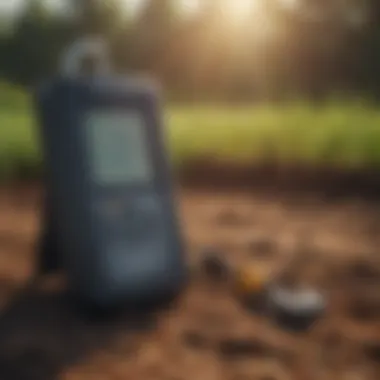Understanding Hanna Instruments TDS Meters for Agriculture


Intro
Total Dissolved Solids (TDS) meters play a crucial role in various sectors, particularly in agriculture. These devices measure the concentration of dissolved substances in water, providing farmers and horticulturists valuable data for their crops. Hanna Instruments, a prominent name in this field, offers diverse TDS meters that cater to different requirements.
Understanding TDS meters requires grasping basic concepts and terminology associated with their operation. This article guides readers through these essential ideas, practical applications, and current trends in TDS measurement. The goal is to equip agriculture professionals with comprehensive insights, enabling them to make informed decisions in crop management and soil health practices.
Understanding Total Dissolved Solids
Total Dissolved Solids (TDS) is a crucial measure in both agricultural practices and environmental monitoring. Understanding this concept is vital for farmers and anyone involved in the cultivation of crops. TDS refers to the total concentration of dissolved substances in water, including minerals, salts, and organic matter. More importantly, it offers insight into water quality, which directly affects plant health.
Definition of TDS
TDS indicates the combined content of all inorganic and organic substances present in a liquid. It is typically measured in parts per million (ppm) or milligrams per liter (mg/L). A TDS meter is an essential tool for anyone looking to gauge the quality of water, helping to identify if the dissolved solids��’ levels are appropriate for agricultural use.
Importance of TDS Measurement
Measuring TDS is essential for several reasons. Firstly, high levels of TDS can negatively impact plant growth by interfering with nutrient uptake. Secondly, it can harm soil structure, affecting drainage and aeration. By accurately assessing TDS, farmers can make informed decisions about irrigation practices and fertilization. This measurement contributes to optimizing crop yield while ensuring sustainable farming techniques.
Components of Dissolved Solids
Dissolved solids include various substances that can be categorized into three main components: salts, organic matter, and metals. Each of these plays a distinct role in the overall composition of TDS and can influence agricultural outcomes.
Salts
Salts are among the most significant contributors to TDS. They often come from fertilizers and can impact soil and water quality. High levels of salts can lead to salinity, which is detrimental to crops. Salts can dissolve easily in water, which aids in their transportation. Farmers should monitor salt levels closely for effective crop management.
Organic Matter
Organic matter consists mainly of decomposed materials from plants and animals. It is crucial for enhancing soil fertility and structure. Organic matter can help maintain moisture levels in soil while also promoting various microbial activities. Notably, the presence of organic matter can moderate TDS levels, potentially reducing the negative impacts of excessive dissolved solids. This reflects the importance of a balanced approach in managing organic inputs in farming practices.
Metals
Metals include elements like iron, copper, and zinc, which can also appear in TDS measurements. While some metals are essential for plant growth in trace amounts, elevated levels can be harmful. They can accumulate in the soil and potentially enter the food chain. Understanding the metal composition in TDS is crucial for ensuring food safety and environmental health as farmers strive for sustainable practices.
"Monitoring TDS levels helps in maintaining healthy soil and crop growth. Ignoring this can lead to unforeseen agricultural challenges."
In summary, each component of TDS provides valuable information that can significantly affect agricultural practices. Keeping track of salts, organic matter, and metals is essential for farmers aiming to optimize crop yield and maintain sustainable farming techniques.
The Role of TDS Meters in Agriculture
Total Dissolved Solids (TDS) meters have become an essential tool in agriculture. The care and management of crops rely heavily on the quality of water and soil in which they are cultivated. TDS meters serve to quantify the concentration of various dissolved substances, aiding in crafting informed agricultural practices. High levels of TDS can indicate issues that could hinder plant growth. Understanding how to utilize these meters effectively is pivotal for both novice and experienced farmers.
Applications in Soil Health Assessment
One of the primary applications of TDS meters is in soil health assessment. Monitoring TDS levels in soil helps determine the presence of necessary nutrients. Excessive TDS can lead to salinity issues, which may damage crop roots and affect growth. Regular monitoring can inform farmers about potential soil amendments needed to maintain balance.
Utilizing TDS meters, farmers can discover the following:
- Presence of salts and minerals
- Soil nutrient profile
- General soil salinity levels
By assessing these factors, farmers can proactively manage soil quality and enhance crop conditions.
Monitoring Irrigation Water Quality
TDS meters are crucial for monitoring irrigation water quality. Water with high TDS can lead to poor absorption by plants and reduced crop yield. Farmers use these meters to analyze irrigation sources to ensure water quality is suitable for crop needs. The application of a TDS meter allows for:
- Early detection of water contamination
- Assessment of water filtration systems
- Evaluation of water treatment effectiveness


Maintaining optimal TDS levels in irrigation water helps in sustaining healthy plant growth and maximizing yield potential.
Influence on Crop Yield
TDS levels have a direct influence on crop yield. Both too high and too low TDS can yield negative effects on crops. High TDS often correlates with high salinity levels, which can inhibit plant growth. This condition limits the crops’ access to essential nutrients, often leading to stunted growth or even crop failure. On the other hand, low TDS levels might indicate a lack of essential minerals, potentially impacting their health and productivity.
Farmers must:
- Regularly measure TDS during growth phases
- Adjust fertilizers based on TDS readings
- Consider TDS metrics during specific growing seasons
By being aware of these levels, farmers are empowered to make real-time adjustments to increase yield, promoting efficient agricultural practices.
Overview of Hanna Instruments TDS Meters
Understanding the capabilities of TDS meters from Hanna Instruments is crucial for those in agriculture and horticulture. A proper TDS meter measures the total dissolved solids in water, which indicates its quality and suitability for different agricultural practices. Hanna Instruments has established a reputation in this field by providing reliable and efficient tools for farmers and enthusiasts alike.
These devices enable farmers to monitor the levels of nutrients and contaminants in irrigation water, thereby making informed decisions on soil health and crop management. A comprehensive knowledge of the various models available helps users select a meter that fits their specific needs. The TDS meters from Hanna Instruments integrate advanced technology, which enhances ease of use while ensuring accuracy.
In this section, we will delve into the defining features of Hanna Instruments TDS meters, exploring their models, technical specifications, and how they address agricultural challenges effectively.
Prelims to Hanna Instruments
Hanna Instruments has been a player in the field of analytical instrumentation since 1978. The company is known for its innovative approach, producing a wide array of testing instruments, including those for measuring TDS. Their meters are designed to meet the needs of professionals in various fields, particularly in agriculture. The emphasis on quality and user-friendly design has led to widespread adoption of their TDS meters.
Popular TDS Meter Models
Hanna Instruments offers several TDS meter models, each tailored to specific needs and applications.
Model HI
Model HI 98331 is known for its compact design and durable construction. It stands out in the TDS meter market due to its ease of use. This model features a backlit display, which enhances visibility in different lighting conditions. The portability allows for on-the-field monitoring, which is very important for farmers.
A unique feature of the HI 98331 is the automatic temperature compensation, which ensures that the readings are always accurate, regardless of the water temperature. This model is well-suited for users who require quick and reliable measurements in various scenarios.
Model HI
Model HI 98201 is another popular choice among users. This model offers a broader measurement range, making it adaptable for various applications. Farmers looking to monitor irrigation water or aquaculture can find this TDS meter particularly beneficial.
One of the distinguishing features of the HI 98201 is its digital calibration, allowing users to perform adjustments without complicated procedures. This ease of calibration makes it an attractive choice, especially in field settings where conditions can quickly change.
Model HI
Model HI 98302 is designed for more comprehensive water quality analysis. It provides both TDS and temperature readings at a glance. The device is well-built for those requiring detailed data on water quality over time, such as aquaponics systems or intensive agriculture.
A notable feature of the HI 98302 is its ability to store multiple readings, allowing users to track changes and trends over an extended period. This capability makes it an invaluable tool for monitoring water quality in dynamic agricultural environments.
Technical Specifications
The technical specifications of Hanna Instruments TDS meters enhance their usability and reliability.
Measurement Range
The measurement range of a TDS meter indicates the scope of TDS values it can read. Hanna Instruments TDS meters provide a wide range of measurement, from very low to high TDS levels. Having a wide range means the user can apply the meter in various scenarios, whether testing drinking water or agricultural runoff.
This capability is particularly beneficial for farmers who deal with different water sources, ensuring they have accurate data regardless of the conditions.
Accuracy
Accuracy is vital when measuring TDS, as it directly affects farming decisions. Hanna Instruments ensures high accuracy in its TDS meters, with most models capable of achieving readings within a few percentage points of the actual TDS levels. This reliability allows users to develop precise management plans based on credible data.


Having an accurate device is essential to prevent issues related to over-fertilization or under-nutrition, both of which can significantly affect crop health and yield.
Calibration Features
The calibration features of Hanna Instruments TDS meters are user-friendly and essential for maintaining measurement integrity. Most models come with an automatic calibration function, simplifying the process and encouraging regular use. Proper calibration ensures that the meter delivers valid measurements over time, which is crucial for ongoing agricultural assessments.
Regular calibration helps to catch potential errors early, allowing for timely adjustments in management strategies.
Choosing the Right TDS Meter
Choosing the right TDS meter is crucial for any agricultural application. The accuracy of TDS readings can significantly impact irrigation practices, soil management, and crop yields. Understanding specific features and personal needs will lead to a more informed decision. Below are the key considerations when selecting a TDS meter, along with insights into its potential benefits.
Factors to Consider
Purpose of Use
The purpose of use defines the type of TDS meter required. Different applications, such as monitoring water quality or assessing soil health, might need varying specifications. For example, if the primary goal is checking irrigation water, measuring higher ranges may be necessary. It's essential to choose a meter that aligns not only with the intended use but also with operational conditions such as temperature and salinity. This choice benefits users by ensuring that data collected is relevant and applicable to their specific agricultural practices.
Budget Constraints
Budget constraints play a vital role in the selection process of a TDS meter. There are many models available at various price points. A potential buyer may find entry-level meters adequate for simple measurements, while advanced models, though pricier, offer enhanced features. Therefore, determining the budget upfront aids in narrowing down choices to those that provide the best value without overspending. It is wise to balance features against cost to ensure an optimal fit for personal needs.
Ease of Use
Ease of use is another significant factor. A user-friendly design can make a difference in frequent measurements. Many TDS meters today have straightforward controls and clear displays, making operation accessible even for beginners. This aspect also relates to calibration; a simpler calibration process is desirable. Users benefit from quicker measurements and less time spent troubleshooting complex gadgets. Overall, ease of use contributes to efficient workflow in regular farming practices.
Comparison with Other Brands
When considering a purchase, it is prudent to compare Hanna Instruments with other brands in the market. While Hanna offers robust features and reliability, assessing alternative brands like Milwaukee Instruments or Apera Instruments can help identify the best match based on distinct requirements. Brand reputation, customer service, and warranty features should also be part of the assessment. This comprehensive approach ensures that users make the most beneficial and informed decisions for their agricultural needs.
How to Use a TDS Meter Effectively
Using a TDS meter properly is essential for accurate readings. Understanding how to use these tools affects results and conclusions drawn from the data. TDS meters measure the concentration of dissolved solids in water, which can affect plant health and overall crop productivity. Therefore, knowing the correct method of usage becomes crucial for any agricultural practice.
Basic Operation Steps
Operating a TDS meter is fairly straightforward, yet specific steps ensure accuracy. Begin by turning on the device and allowing it to warm up for a short period. Take the sample water in a clean container. Submerge the probe of the TDS meter into the water without touching the sides of the container. After a few seconds, the meter will display the TDS level.
Make sure to rinse the probe with distilled water after each measurement. This reduces cross-contamination and provides more reliable readings in subsequent tests. It is also advised to follow the manufacturer's instructions related to your specific model, as they may have additional specific recommendations.
Best Practices for Accuracy
Maintaining accuracy is vital for the effectiveness of TDS measurement. Following established best practices helps ensure that the readings are as reliable as possible.
Sample Preparation
Sample preparation plays a significant role in the overall reliability of TDS readings. Use distilled water or clean water free from contaminants for rinsing and diluting as required. This is crucial because any impurities may skew the results, leading to incorrect interpretations. The primary characteristic of effective sample preparation is cleanliness, which minimizes variability in readings. One unique feature of careful sample preparation is that it allows for better accuracy in testing different types of water samples, such as irrigation water versus pond water.
Advantages of diligent sample preparation include obtaining consistent results across different tests. This contributes positively to making informed decisions in agriculture. However, hastily prepared samples can lead to questionable results, which may impact crop management adversely.
Calibration Techniques
Calibration techniques ensure that the TDS meter provides reliable and precise readings. Regular calibration against standard solutions enhances the meter's accuracy over time. One key characteristic is that it compensates for any drift in readings due to age or environmental conditions. The calibration process may involve using known TDS standards to adjust the meter accordingly. This makes it a preferred choice for maintaining performance in various operational situations.
One unique aspect of calibration is that it is typically recommended to calibrate the meter before initial use and regularly thereafter, depending on usage frequency. The advantages of a properly calibrated device include increased confidence in reading accuracy, whereas neglecting calibration may lead to significant errors in measurement, ultimately affecting agricultural decisions.
Interpreting TDS Meter Readings
Understanding readout values from TDS meters is crucial for farmers and agricultural enthusiasts. This knowledge allows for informed decision-making regarding soil and water quality. Accurate interpretation of TDS readings can steer agricultural practices towards sustainability. Various agricultural dilemmas can arise from unclear readings or misconceptions regarding TDS values. Thus, knowing how to interpret these readings can significantly impact productivity and sustainability.


Understanding Readout Values
TDS meters provide numerical readings that typically represent the total dissolved solids in water, expressed in parts per million (ppm) or milligrams per liter (mg/L). The typical range for freshwater sources might vary from 0 to 1000 ppm, although specific circumstances can see readings outside this range.
For instance, a reading of 0-100 ppm usually indicates good water quality and minimal dissolved solids, while values of 500 ppm and above may signify increased concentrations of minerals and contaminants. This knowledge is fundamental for evaluating irrigation water, ensuring crops receive the right nutrient balance, and preventing potential toxicity.
Implications of High TDS Levels
High TDS levels can be a double-edged sword in agriculture. On one hand, it may suggest good nutrient availability; on the other hand, it also raises concerns regarding salinity. In some cases, elevated TDS levels can lead to harmful soil or water conditions. Higher salt concentrations can harm plant health, causing physiological stress or even death in extreme cases.
Farmers should remain vigilante about these readings. It may be useful to implement soil amendments or alter irrigation practices to mitigate high TDS impacts. Regular monitoring is vital in preventing potential damage from uncompromising salinity.
Impact of Low TDS Levels
Conversely, low TDS levels can indicate a lack of essential nutrients in water, which might be detrimental to crops over time. If plants are provided with low nutrient water, growth may be stunted, and overall yields could decline. It’s essential to maintain an appropriate balance, ensuring the water supply meets the crop’s nutritional requirements.
In some situations, low TDS can point to clean, unpolluted water sources, which is favorable. However, one must also evaluate the potential nutrient deficits. Thus, integrating regular TDS meter readings into irrigation management plans can greatly enhance crop production and soil health.
Understanding TDS readings is essential for ensuring optimal water quality, hence maximizing crop yield and promoting sustainable farming.
Maintaining Your TDS Meter
Maintaining your TDS meter is crucial for ensuring accurate measurements and overall longevity of the device. Regular maintenance can prevent inaccuracies that might lead to poor agricultural decisions. Proper care is essential, as any deposits or residues can affect the performance of the meter. Farmers who rely on these devices need to ensure their tools are always in top working condition. This section outlines important aspects regarding the maintenance of TDS meters, focusing on cleaning, calibration, and troubleshooting.
Regular Cleaning and Care
Regular cleaning is vital for maintaining the performance of a TDS meter. The instrument can accumulate dirt, salts, and other residues from the water samples it measures. It is recommended to clean the probe after each use, using distilled water to rinse it off. Avoid using tap water, as it can introduce more ions that could affect the readings. If needed, a soft brush can be used carefully on the probe to remove stubborn residues.
Additionally, it is important to store the TDS meter properly. Keeping the device in a protective case when not in use can help prevent physical damage. If the meter comes with a specific storage solution, it should be used to maintain the probe's effectiveness. In some cases, not applying proper cleaning and care can lead to a shortened lifespan of the equipment.
"Regular maintenance prolongs the life and improves the accuracy of your TDS meter."
Calibration and Adjustments
Calibration is another essential step in maintaining your TDS meter. Not calibrating your instrument can lead to inaccurate readings over time. It is advisable to calibrate your meter before each use, especially if the readings appear inconsistent. Most TDS meters come with calibration solutions, typically at known TDS levels. By measuring the solution and adjusting the meter accordingly, you ensure accurate results.
Calibration should also involve checking the meter’s response to different TDS levels. This ensures the device remains reliable in varying conditions. Additionally, it is wise to document the calibration dates, resolutions used, and any adjustments made for future reference. Some meters may have automatic calibration features, but it is important for users to confirm that the process functions correctly.
Common Troubleshooting Tips
Even with proper maintenance, issues can arise with your TDS meter. Below are some common troubleshooting tips:
- Inconsistent Readings: If you notice fluctuations in the readings, first check for any residues on the probe. If the probe is clean, re-calibrate the device and test it again using fresh calibration solutions.
- Probe Sensitivity: Over time, the sensitivity of the probe may decline. If you feel the readings are off, consider replacing the probe if it shows signs of aging or damage.
- Display Issues: If the display seems malfunctioning, check the batteries. Replacing them may solve the problem.
- Software Updates: For advanced models, ensure the software is up to date. This can improve performance and fix bugs that could be affecting your readings.
Real-world Case Studies
Real-world case studies present valuable insights into the practical application of TDS meters, specifically those developed by Hanna Instruments. By showcasing specific instances where these devices have significantly impacted agricultural practices, we can illustrate their relevance and effectiveness in varied settings. These examples not only emphasize the importance of measuring total dissolved solids but also highlight the versatility of Hanna Instruments TDS meters. They reveal how such tools support farmers and agricultural enthusiasts in making informed decisions about crop management and water quality.
Successful Implementation in Greenhouses
In greenhouse settings, where control of environmental variables is paramount, TDS meters serve a crucial role. By monitoring the concentration of dissolved solids in nutrient solutions, growers can ensure that their plants receive optimal nutrients without the risk of toxicity. For example, a greenhouse cultivating tomatoes experienced stunted growth and reduced yields attributed to high TDS levels in the water supply. By employing a Hanna Instruments TDS meter, the growers quickly identified the issue. They adjusted the composition of their nutrient solutions, ultimately enhancing plant growth and productivity.
The TDS meter provided accurate, real-time data, enabling quick adjustments to nutrient mixes. This case underscores the importance of consistent TDS monitoring in greenhouses, ensuring not only plant health but also operational efficiency. With appropriate adjustments based on TDS readings, growers can minimize waste and control costs while maximizing yield potential.
TDS Measurement in Aquaponics
Aquaponics is another area where the application of TDS meters like those from Hanna Instruments is critical. In aquaponics systems, fish and plants are cultivated together in a symbiotic environment. Maintaining the right balance of nutrients is essential for both fish health and plant growth. High levels of dissolved solids can lead to harmful conditions for fish, while inadequate levels can hinder plant development.
A study involving a small aquaponics farm demonstrated the benefit of TDS measurement in maintaining system balance. Initially, the farm struggled with fish mortality linked to poor water quality. By integrating a TDS meter from Hanna Instruments, the farmer could measure how the nutrient levels fluctuated over time. Adjustments made based on TDS readings resulted in improved water quality, leading to healthier fish and robust plant growth.
This case exemplifies how TDS meters contribute not just to productivity but also to system sustainability in aquaponics. By understanding the significance of total dissolved solids, farmers engaged in aquaponics can enhance their systems' resilience, leading to better environmental outcomes and higher harvests.
Monitoring TDS levels is essential for the health of both fish and plants in aquaponic systems.
Through detailed examinations of these real-world applications, we observe the profound effect that TDS meters have on agricultural outcomes. Their use not only safeguards crop health but also optimizes resources, making them indispensable tools in modern agriculture.







